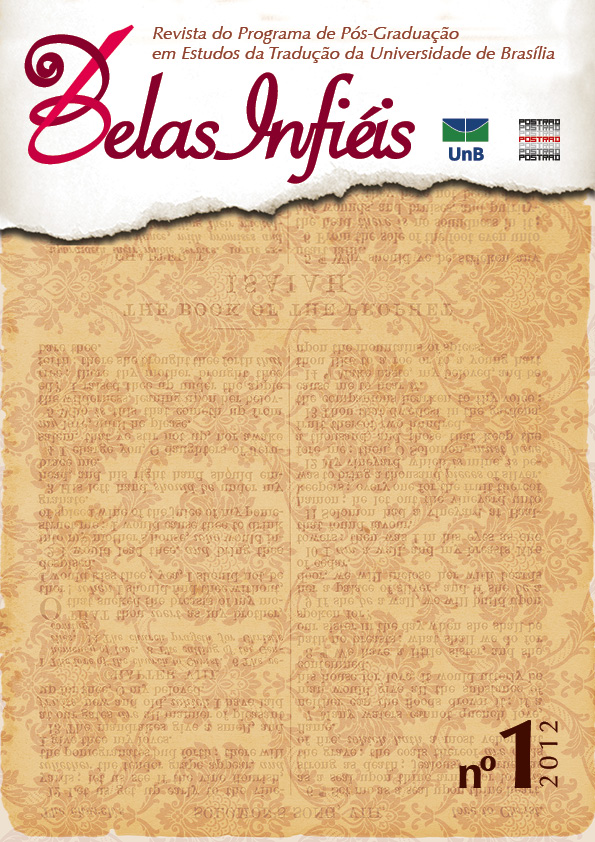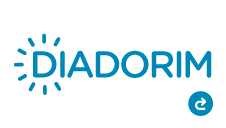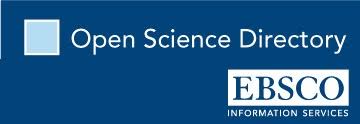TRADUÇÃO:
FERRAMENTA EFICAZ NO ENSINO-APRENDIZAGEM DE LÍNGUAS ESTRANGEIRAS PARA O ALUNO DO ENSINO SUPERIOR
DOI:
https://doi.org/10.26512/belasinfieis.v1.n1.2012.11168Palabras clave:
Tradução, ferramenta, línguas estrangeiras, ensino superiorResumen
O aluno do ensino superior demanda uma didática diferente daquela usada para ensinar o aluno do ensino básico e, por causa dessa necessidade, surge a Andragogia. Essa ciência objetiva refletir sobre a didática necessária para a aprendizagem do aluno adulto. Por causa disso, também ocupa um papel central no ensino de línguas estrangeiras (LEs), que, nesse âmbito, tem Tradução e Gramática como primeiro método para ensinar e aprender latim e grego antigo. Como método para ensinar e aprender línguas modernas, esse método não teve sucesso. Tentou-se, então, marginalizar ou até mesmo excluir a tradução da sala de aula, porém, não houve êxito: a tradução mental, oral ou escrita não pode ser evitada. Portanto, este artigo objetiva discutir e analisar a inserção da tradução como ferramenta eficaz no ensino-aprendizagem de LEs do aluno na fase do ensino superior.
Descargas
Citas
ALMEIDA, V. Abordagem comunicativa no ensino de língua estrangeira ”“legado de Dell Hymes ou de Noam Chomsky? In: VII Congresso Internacional da ABRALIN, 2011, Curitiba. Anais do VII Congresso Internacional da ABRALIN.Curitiba:UFPR, 2011, p. 4378-4388. Disponível em: <http://www.abralin.org/abralin11_cdrom /artigos/Virgilio_ Almeida.PDF> Acesso em: 10 jan. 2012.
ANTUNES, C.A afetividade na escola:educando com firmeza. Londrina: Maxiprint, 2006.
BALBONI, P. E. A tradução no ensino de línguas: história de uma difamação.In-Traduções,2011. Disponível em:<http://www.pget.ufsc.br/in-traducoes/>. Acesso em: 09 mar.2011.
BRUST, J. R. A influência da afetividade no processo de aprendizagem de crianças nos anos iniciais do ensino fundamental. Trabalho de Conclusão de Curso: Londrina, 2009. Disponível em:<http://www.uel.br/ceca/pedagogia/pages/arquivos/JOSIANE%20REGINA%20BRUST.pdf> Acesso em: 08 nov. 2011.
CASADO, A.; GUERRERO, M. La traducción como estrategia cognitiva em elaprendizaje de segundas lengua.In: El español como lengua extranjera: de la teoría al aula. Actas del III Congreso Nacional de ASELE, Málaga,1993,p. 393-402.
CAVALCANTI, R. A. Andragogia: A aprendizagem nos adultos. Rev. deClínica Cirúrgica da Paraíba, n.6, Ano 4, Jul. 1999.
CEIA, C. Por que é importante estudar línguas e por que é que não estudamos. 2006. Disponível em: <http://www.fcsh.unl.pt/docentes/cceia/images/stories/PDF/educare /aprender_linguas.pdf>. Acesso em 30 mar. 2012.
COSTA, W. C. Tradução e ensino de línguas. In BOHN H. I; VANDRESEN, P. Tópicos de Lingüística Aplicada ao ensino de línguas estrangeiras. Florianópolis: UFSC, 1988. p. 282-291.
DAMIANI, M. F. e NEVES, R. A. Vygotsky e a teorias da aprendizagem. Unirevista, v.1, n. 2, 2006. Disponível em: <http://www.miniweb.com.br/educadores/Artigos/PDF/vygotsky. pdf>. Acesso em:06 mar. 2012.
GAMBOA, L. La traducción como destreza de mediación: Hacia La construcción de una competencia plurilingüe y pluricultural en el estudiante de E/LE. Memoria de Máster. BibliotecaUniversidad Antonio de Nebrija, 2004.Disponível em: <http://www.educacion.gob.es/dctm/redele/Material-RedEle/Biblioteca/2004_BV_02/2004_ BV_02_09Gamboa.pdf?documentId=0901e72b80e5bf59> Acesso em: 10 dez. 2011.
HERNANDEZ, M. R.La traducciónpedagógica en la clase de E/LE.In: Actas del VII CongresoASELE,1998,p. 249 -255.Disponível em: <http://cvc.cervantes.es/ensenanza/ biblioteca_ele/asele/pdf/07/07_0247.pdf>. Acessoem: 02 fev. 2012.
HOUAISS, A.; VILLAR, Mauro de Salles. Dicionário Houaiss da língua portuguesa.Rio de Janeiro: Objetiva, 2001.
JALIL, S. Estudar uma língua estrangeira? Para quê? 2008. Disponível em: <http://www.educacional.com.br/revista/0308/pdf/18_SalaAula_LInglesa.pdf>. Acesso em:25 mar. 2012.
LEFFA, V. J.Metodologia do ensino de línguas. In:BOHN, H. I.; VANDRESEN, P. Tópicos em lingüística aplicada:O ensino de línguas estrangeiras. Florianópolis: UFSC, 1988. p. 211-236.
___________. O ensino de línguas estrangeiras no contexto nacional. APLIESP, n. 4, p. 13-24, 1999.
MACIEL, K. D. Métodos e abordagens de ensino de língua estrangeira e seus princípios teóricos. 2004. Disponível em: <http://www.apario.com.br/index/boletim.php>. Acesso em: 24 jan. 2012.
MOROSOV, I.; MARTINEZ J. Z. A didática do ensino e a avaliação da aprendizagem em língua estrangeira. Curitiba: Ibpex, 2008.
NOGUEIRA, M. O. G. Aprendizagem do aluno adulto: implicações para a prática docente no ensino superior. Curitiba: Ibpex, 2009.
PEGENAUT, L. La traducción como herramienta didáctica.In: Contextos, nº 27-28, Madrid, p. 107-126, 1996.Disponível em: < https://buleria.unileon.es/bitstream/handle/10612/955/05.-Luis.Pegenaute.pdf?sequence=1>. Acesso em 02 mar.2012.
PEREIRA, M. S. N. Onde está a criatividade?1998. Disponível em:<http://www.nuted.ufrgs.br/objetos_de_aprendizagem/2009/criativas/midiateca/modulo_1/Criatividade%20na%20perspectiva%20de%20Vygotsky.pdf> Acessoem:07nov. 2011.
ROMANELLI, S. O uso da tradução no ensino-aprendizagem das línguas estrangeiras. Revista Horizontes de Linguística Aplicada, v. 8, n. 2, p. 200-219, 2009. Disponível em:<http://www.red.unb.br/index.php/horizontesla /article/view/2942/2546> Acesso em:08 nov. 2011.
___________. Traduzir é criar? Letras de Hoje, v. 45, p. 62-66, 2010. Disponível em: <http://revistaseletronicas.pucrs.br/ojs/index.php/fale/article/viewFile/8555/6069.Acesso em: 02 jun.2011.
___________. Traduzir ou não traduzir em sala de aula? Eis a questão.Revista Inventário,v.5, 2006. Disponível em:<http://www.inventario.ufba.br/05 /05sromanelli.htm>.Acesso em:22 nov. 2011.
ROSA, P. R. S. Instrumentação para o ensino de ciências.Campo Grande: UFMS, 2010. Disponível em: <http://gw-ead.ufms.br:8080/xmlui/handle /123456789/23>. Acesso em: 04 nov. 2011.
SOUZA, J. P. Tradução e ensino de línguas. Ceará: Revista do GELNE, ano 1, n. 1, 1999. Disponível em: <http://www.gelne.ufc.br/revista_ano1_no1_27.pdf>. Acesso em:15 jan. 2012.
VILAÇA, M. L. C. Métodos de Ensino de Línguas Estrangeiras: fundamentos, críticas e ecletismo. Revista Eletrônica do Instituto de Humanidades, v.2, n. 26, 2008. Disponível em: <http://publicacoes.unigranrio.edu.br/index.php/reihm/article/view /43/78> Acesso em:22 nov. 2011.
Descargas
Publicado
Cómo citar
Número
Sección
Licencia
Copyright Statement
Given the public access to this journal, the texts are free to use but requires the recognition of the original authorship and initial publication in this journal to be properly stated.
The journal allows the use of works published for non-commercial purposes, including the right to submit the work to publicly accessible databases. Published contributions are the sole and exclusive responsibility of the author(s).
- When submitting papers to be evaluated by the Belas Infiéis journal, the author(s):
- Declare that the contents of the contributions are original and of their original creation, being entirely responsible for their content if there is an objection by third parties.
- Claim to be aware that they should not commit academic plagiarism.
- Declare that the manuscript has not been published, completely or partially, in Portuguese or another language. If it is a translation it should be submitted to the Translated Articles section.
- Declare that the manuscript is not being evaluated by other journals.
- Declare that the manuscript was not submitted to another journal simultaneously.
- Commit(s) to inform the journal of any kind of error or inaccuracy in their contribution (published, in evaluation or in editing) and to collaborate with the editors to make due corrections of the article (when in evaluation or editing) or erratum/retraction (after publication).
- Declare that there is no conflict of interest regarding the published work.
- Authorize its release if it is accepted for publication without any kind of monetary compensation.
- Agree to assign non-exclusive rights to publication to the magazine, remaining free to make their contribution available in other media as long as the publication of the first version in Belas Infiéis magazine is mentioned. They also authorize Belas Infiéis to assign their texts for reproduction in content indexers, virtual libraries and similar platforms.
- Maintain copyright and grant the journal the right of first publication, the work being licensed under theCreative Commons Attribution License.
- Is/Are allowed and encouraged to publish and distribute their work online after the editorial process, which may increase the impact and citation of the published work.
- Authorize the editorial team to make textual adjustments and to adapt the article to the publication rules, when necessary.



















